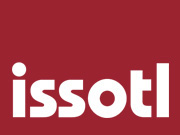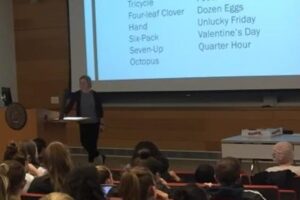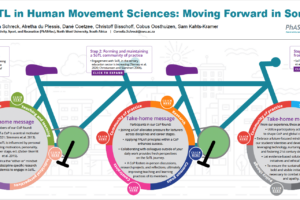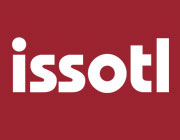The SoTL Lit Review, The SoTL Librarian
- Posted by ISSOTL Admin
- Categories Blog
- Date February 13, 2016
- Comments 0 comment
As Teaching & Learning Inquiry co-editor Gary Poole and I have observed, one of our reviewers’ most common reasons for sending a submission back to the author (for revisions or rejection) is the need for a stronger grounding in relevant research on teaching and learning—an effective SoTL lit review.
Last week, Margy MacMillan led a two-hour workshop on the SoTL lit review here at the University of Calgary’s Taylor Institute for Teaching and Learning. Margy is professor and instruction librarian at Mount Royal University, just across the Bow River. In the world of the scholarship of teaching and learning, Margy is a powerful presence behind the scenes as undoubtedly the most active librarian in the international SoTL community. She calls 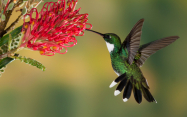
I can’t remember the last time I got so many queries about an event being recorded, repeated, or documented in some way. TLI reviewers aren’t the only ones aware of the need for stronger lit reviews in SoTL work: it’s one of the main sources of anxiety in SoTL (Chick, et al. 2014). And so I offer some of the highlights of Margy’s workshop—and recommend other Centers and Institutes to invite her to campus (in person or via Skype) to do the full workshop with local colleagues.
What makes searching SoTL different from the familiar experiences of searching within our disciplines?
- She told us to “search the way [we] did as undergraduates.” Unlike our areas of expertise in which we know the major researchers, we may not know the big names relevant to our SoTL project, so we should go back to searching by subject (Foster, 2010).
- The SoTL literature “isn’t networked very well and doesn’t cite itself well,” so rather than the more typical searchable connections that look like a big tree, “SoTL is a strawberry field,” and we need to look within a variety of patches.
- Unsurprisingly, the search terms will be different from what we’re used to, and we may not have taken the time to systematically collect search terms in years. Margy gave us five minutes to develop clusters of terms relevant to our area of interest, which we’d shared during introductions:
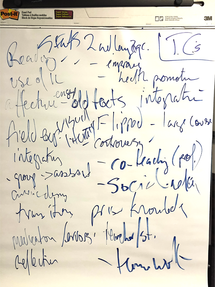
- Margy’s notes about potential areas of interest among the workshop participants
- the phenomenon: field experiences, prior knowledge, reading, teamwork, visual thinking
- the population: undergraduate students, graduate students, at-risk students
- methods and their related terms: quantitative (surveys, sample), qualitative (emergent themes, close reading, grounded theory, Glaser and Strauss), longitudinal
- other: effective, benefits, “significant difference,” signature pedagogy
- discipline: our own, but also others “where there might be a common issue, pedagogy, method, etc” (Margy intentionally and emphatically places this search last, so we don’t myopically fall back on searching in the familiar places. She mentioned her study of student reading, which led her into the unfamiliar but highly relevant territories of phenomenography, close reading, and neurobiology.)
- Many of the articles we find will probably be different from those we’re used to, and we can react to this unfamiliarity with the same frustration and resistance as our students (Weller, 2011). We have to be open to new terms, methods, and article styles, formats, and lengths.
- Here’s where you’d be wise to bring Margy in for a workshop at your institution. She worked with our institution’s library website before taking us out to the wider internet.
- Start with our library’s specific discovery system, or the search box set up to cut across its catalogue and databases, such as ours.
- Also search dissertations and theses, not only for the “Growing body of thesis literature on teaching and learning,” but also “for their bibliographies and instruments.”
- She encouraged us to use Mendeley, a reference manager and PDF organizer for cataloging sources we may use. At this stage, we can search Mendeley for sources others have collected (e.g., SoTL AND graduate education).
- She pointed us to Google Scholar, not only because it’s sure to search across disciplines but also because it includes more open access materials, and because its powerful “Cited by” function is a great way to start exploring the relevant literature. (See image above.)
- We can also set up alerts for our searches to learn about new sources related to our query.
- Here are what some sample searches look like:
- SoTL graduate education pedagogy
- “pedagogy training” effective “graduate students”
- SoTL (“graduate education” OR “teaching assistant”)
- To narrow the search, use the intitle: command before a key term or the specific context (e.g. SoTL graduate education intitle:humanities) or allintitle: to narrow even further (e.g., allintitle:SoTL graduate humanities)
- Using many words is also helpful, as full texts are being searched (e.g., “scholarship of teaching and learning” “microteaching” graduate education qualitative effective humanities).
- Margy accurately notes that “not all SoTL work makes it into scholarly literature,” so regular Google will show us conference presentations, in-house publications, blog posts, and the like.
- The allintitle: command is especially useful in Google.
- She encouraged us to “think geographically” because teaching and learning environments and approaches and the resulting scholarship can vary by location. (Think of the Oxford tutorial in the UK.)
- To search academic sites within the UK: SoTL “graduate student” site:ac.uk
- In the US: SoTL “graduate student” site:edu
- In Australia: SoTL “graduate student” site:edu.au
- There is no set academic domain for Canada, but she shared her custom Google search for Canadian academic searches.
Previous post
